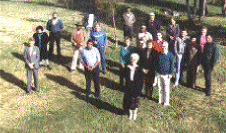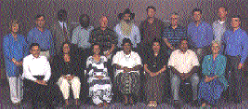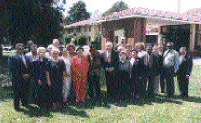Chapter
2 THE
COUNCIL -CHARTING THE WAY
The Council for Aboriginal
Reconciliation was established as a statutory authority on 2 September 1991
when the Council for Aboriginal Reconciliation Act 1991 received the
Royal Assent.
Its first members were
appointed on 15 December 1991. Like other appointees over the Council's life,
they were prominent Australians drawn from Aboriginal, Torres Strait Islander
and wider communities, bringing a comprehensive range of views and approaches
to the Council's deliberations. A list of all members over the three terms of
Council is included at Appendix 4.
|
All Council
members are proud to be actively involved in the reconciliation process,
and consider it an honour to be part of this noble enterprise to shape
the future of our nation.
Patrick
Dodson, Chairperson, Council for Aboriginal Reconciliation 1991-97,
(1992)
|
The preamble to the Act sets
out some of the reasons for, and circumstances surrounding, the enactment of the
legislation. The preamble reads:
Because:
(a) Australia was
occupied by Aborigines and Torres Strait Islanders who had settled for thousands
of years, before British settlement at Sydney Cove on 26 January 1788; and
(b) many Aborigines
and Torres Strait Islanders suffered dispossession and dispersal from their
traditional lands by the British Crown; and
|
...whether
this Council provides the impetus for the Australian population to look
to its future with some hope and unity, I do not know. But it is my sincere
hope that it will do just that...
Dr
Michael Wooldridge, Shadow Minister for Aboriginal Affairs (1991)

Inaugural Council
members stand on an imaginary map of Australia to indicate the places
they come from, 1992.
Photo: AUSPIC.
|
(c) to date, there
has been no formal process of reconciliation between Aborigines and Torres Strait
Islanders and other Australians; and
(d) by the year 2001,
the centenary of Federation, it is most desirable that there be such a reconciliation;
and
(e) as part of the
reconciliation process, the Commonwealth will seek an ongoing national commitment
from governments at all levels to cooperate and to coordinate with the Aboriginal
and Torres Strait Islander Commission as appropriate to address progressively
Aboriginal disadvantage and aspirations in relation to land, housing, law and
justice, cultural heritage, education, employment, health, infrastructure, economic
development and any other relevant matters in the decade leading to the centenary
of Federation, 2001.
The Council for Aboriginal
Reconciliation Act 1991 also stipulates that the Council must take account
of the fact that the Aboriginal and Torres Strait Islander Commission has specific
functions and responsibilities for matters involving Aboriginal and Torres Strait
Islander Australians, and that it must make use of ATSIC and its regional councils
as the principal means of facilitating
consultation with Aboriginal and Torres Strait Islanders peoples.
The ATSIC Chairperson and Deputy Chairperson have served as ex
officio members of the Council throughout its life.
One of the outcomes of the
extensive public consultation and cross-party discussion leading up to the establishment
of the Council was strict accountability clauses in the legislation intended to
keep the Council goal-oriented. These clauses called for strategic plans to be
prepared for each triennium of the Council's life and for such plans to be approved
by the Minister and laid before each House of the Parliament.
These plans demonstrate
how over the nine years the Council built on its knowledge and experience, readjusted
its programs and defined more specific goals as its work progressed.
Initial meetings of the
Council concentrated on the task of strategic planning, including the adoption
of a vision statement reflecting how the Council wished to see Australian society
in the year 2001:
A united Australia which
respects this land of ours; values the Aboriginal and Torres Strait Islander
heritage; and provides justice and equity for all.
In the following years,
this statement became widely recognised and broadly supported.
Strategic
Plan 1992-95
The first strategic plan
established goals and programs under the broad headings of communication, consultation,
cooperation and community action for the period 1992-1995. Strategies were
designed to:
- communicate with the
nation about the process of reconciliation;
- consult the Australian
community in order to advance the process of reconciliation;
- ensure that, at all levels
of government and the community, there is a commitment to cooperate in furthering
the process of reconciliation; and
- foster cooperative action
to overcome disadvantage, and to increase understanding, with a focus on the
local community level.
|
If there
is one issue that above all else looms large as one to be tackled as we
move to the centenary of Federation, it is this issue of reconciliation
and justice for Aboriginal and Torres Strait Islander people.
The
Hon Robert Tickner, Minister for Aboriginal Affairs and Minister Assisting
the Prime Minister for Aboriginal Reconciliation (1991)
|
Eight
key issues
Council defined eight key
issues as essential to the process of reconciliation in its first strategic
plan. These issues were identified by Aboriginal and Torres Strait Islander
peoples as essential to any understanding of their past, their position in the
present and their hopes for the future. The key issues were the basis of the
Council's community education program throughout its life. They are:
- a greater understanding
of the importance of land and sea in Aboriginal and Torres Strait Islander
societies;
- better relationships
between Aboriginal and Torres Strait Islander peoples and the wider community;
- recognition that
Aboriginal and Torres Strait Islander cultures and heritage are a valued
part of the Australian heritage;
- a sense for all
Australians of a shared ownership of our history ;
- a greater awareness
of the causes of disadvantage that prevent Aboriginal and Torres Strait
Islander peoples from achieving fair and proper standards in health, housing,
employment and education;
- a greater community
response to addressing the underlying causes of the unacceptably high levels
of custody for Aboriginal and Torres Strait Islander peoples;
- greater opportunity
for Aboriginal and Torres Strait Islander peoples to control their destinies
;
- agreement on whether
the process of reconciliation would be advanced by a document or documents
of reconciliation.
Committees
of Council
Under the provision of
section 17 of its legislation, in August 1992 the Council established six committees
to assist its work. The Mining Committee sought ways to improve relations between
the mining industry and Aboriginal and Torres Strait Islander communities. The
Rural Committee identified key issues for reconciliation in the rural sector
on which to base frameworks for practical initiatives. The Industry Committee
worked to enhance employment prospects for Aboriginal and Torres Strait Islander
peoples in the private sector and to end discrimination in the workplace. The
Media Committee developed information and public education strategies, and the
Evaluation, Monitoring and Budget Committee monitored progress in terms of performance
indicators and targets set by the Council.
|
The Opposition
also believes that the process of reconciliation should work to establish
agreed goals and annual benchmarks for progress in such areas as education,
health, housing and infrastructure.
Senator
Grant Tambling, Country Liberal Party, Northern Territory (1991)
|
By the end of its first three-year
term, the Council had identified the major issues, begun comprehensive social
research, lifted the level of public awareness about the process in train, and
started to form strategic partnerships to progress the goals of reconciliation.
A major achievement of this term was the preparation, after extensive consultation
with Aboriginal and Torres Strait Islander communities, of the report Going
Forward - Social Justice for the First Australians which was presented to
the Commonwealth Government on 17 March 1995.
Strategic
Plan 1995-98
The second strategic plan - for
the 1995-1998 triennium - capitalised on the opportunities and community
goodwill generated by the awareness-raising activities of Council's first term.
It sought to achieve demonstrable reconciliation outcomes in local communities
and specific sectors, in line with Council's vision. Council's work focused
on six core strategies which were to:
1. Promote and seek
broad support for the Council's social justice recommendations contained in
its March 1995 submission to the Commonwealth Government, Going Forward:
Social Justice for the First Australians , and work for their adoption and
implementation.
2. Facilitate general
and specific reconciliation agreements between Aboriginal and Torres Strait
Islander and wider communities in localities, regions and sectors of Australian
society.
3. Consolidate and
extend 'advocate networks' of reconciliation supporters across the broadest
possible range of communities, sectors and organisations.
4. Develop and implement
effective reconciliation projects and initiatives at national, State/Territory,
regional and local levels.
5. Determine whether
reconciliation should be expressed in a document or documents, and assist the
negotiation and formulation of such document/s where appropriate.
6. Mediate where appropriate
to improve relations between Aboriginal and Torres Strait Islander and other
Australians.
The Council implemented
the core strategies through three elements of reconciliation activity: Community
Action, Communication and Public Awareness, and Consultation.
The Community Action
element aimed to bring people together to work on issues of common concern,
and to promote cooperative approaches and solutions. It also promoted positive
change in local communities and community organisations to support reconciliation
activities.
The Communication and
Public Awareness element promoted better understanding, knowledge and attitudes
in the broad community, and in targeted sectors, leading to support for, and
involvement in, the reconciliation process.
The Consultation
element sought and recorded the views of Aboriginal and Torres Strait Islander
communities and the wider community about reconciliation and the key issues.
Australians for Reconciliation coordinators acted within
each State and Territory to promote reconciliation at a community
level.
|

Members
of the second-term Council.
Photo: Gilbert Rossi.
|
In adopting this strategic
plan, the Council stressed its view that the nation's ability to achieve reconciliation
would be strongly influenced by the extent to which service-delivery organisations
addressed Aboriginal and Torres Strait Islander disadvantage.
After a minor restructuring,
Council committees included the Executive Committee, Social Justice Committee,
Resources Committee, Media, Education and Consultative Committee, Cultures,
Heritage and Legal Committee, and Economic Committee.
By the end of the second
term, the word 'reconciliation' was part of common parlance. By 1997 National
Reconciliation Week had become established in the national calendar, organised
largely by local communities. The Week of Prayer, established in 1993, had become
the largest annual multi-faith observance in Australia. An estimated 96 new
reconciliation groups sprang from the regional meetings feeding into the May
1997 Australian Reconciliation Convention.
The Convention gave Council
the opportunity to pursue core elements of its statutory obligations under the
Act, including the responsibility to explore the potential benefit and content
of a document or documents of reconciliation. A major report to Parliament
Weaving the Threads - progress towards reconciliation reported on the achievements
of the second term and discussed the challenges of reconciliation. Its submission
marked the end of the term of many foundation members of Council, including
the inaugural Chairperson, Mr Patrick Dodson.
Strategic
Plan 1998-2000
Strategic planning for
Council's final term 1998-2000 took into account the outcomes of the Australian
Reconciliation Convention in May 1997. Among other things, the convention helped
to identify options for change most likely to gain the support of the Australian
people. The plan focused on three key goals that sought to unite individuals,
community groups, organisations, businesses and governments in their support
of a national commitment to reconciliation. These goals were to:
Goal 1: Documents
of Reconciliation
Achieve recognition and
respect for the unique position of Aboriginal and Torres Strait Islander peoples
as the Indigenous peoples of Australia through a national document of reconciliation
and by acknowledgment within the Australian Constitution.
|

Members of
the third-term Council.
Photo: Peter Chin
|
Goal 2: Partnerships
in Reconciliation
Gain the commitment of
governments, business, peak organisations and community groups to form partnerships
which will achieve social and economic equality for Aboriginal and Torres Strait
Islander peoples.
Goal 3: The People's
Movement for Reconciliation
Encourage and support the
people's movement for reconciliation to achieve justice and equity for all Australians,
to embrace the unique place of Aboriginal and Torres Strait Islander peoples
in the life of the nation and to ensure that the work of reconciliation continues
beyond the life of the Council.
Media and Communication
The plan also highlighted
the role of media liaison and public relations to promote:
- greater cultural
awareness and understanding in the media;
- awareness and
understanding, both within Australia and overseas, of the reconciliation process
and Council's work;
- understanding
of reconciliation and its importance for the nation; and
- positive attitudes
towards the reconciliation process.
Council's committees then
developed detailed operational plans, translating the strategic plan into separate
tasks. The five committees for the final term were the Executive Committee,
Documents of Reconciliation Committee, Partnerships in Reconciliation Committee,
People's Movement for Reconciliation Committee, and Media and Communications
Committee.
Highlights of Council's
final term included the presentation of the documents of reconciliation to the
people of Australia at Corroboree 2000 (see Chapter 7), and the extent of commitment
to these documents summarised in Chapter 8.
As foreshadowed in the
debate leading up to the establishment of the Council, the regular strategic
planning process kept the Council focused and goal-oriented. The following chapters
summarise the many initiatives and activities of the Council and its supporters
as it implemented these plans over its decade of operation.